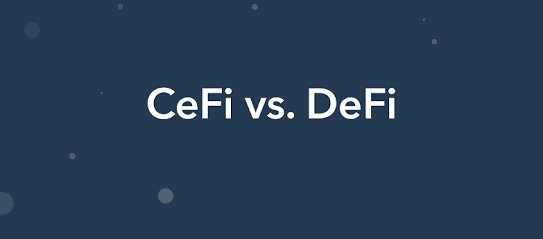CEFI vs DEFI: What's The Fuzz About?

There is a great chance that you may have heard about Decentralized Finance- DeFi- and Centralized Finance- CeFi. These terms have been thrown around a lot, and we are going to analyze what they are.
Centralized vs Decentralised: What Is It?
In the world of finance, two major types of financial platforms exist, and they are CeFi- Centralized Finance- and DeFi- Decentralized Finance.
When people use CeFi, they trust their funds with an institution, and believe that such an organization will manage their funds effortlessly.
As for DeFi, people believe that the system will work as it is expected and programmed to.
CeFi – Centralized Finance
One reason many users are in love with the services that fall under this group is because of the high level of flexibility that they possess. Users of centralized finance tend to enjoy the cross-chain exchange, fiat conversions, access to a customer service team, and so on.
Benefits of Centralized Finance
• Users enjoy the fact that institutions store the keys and secure them. This means that do not have to worry about what happens to the private keys because capable organizations handle everything.
• Users can easily exchange their crypto or tokens for others.
What Does CeFi Entail?
- Verification Process
It is expected that institutions that offer CeFi services undergo the processes outlined by Anti-Money Laundering and Know Your Customer regulations, which are usually followed by many traditional financial institutions.
This means that users will have to surrender personal information before they can use the CeFi services.
- Custodial Wallet
CeFi providers use custodial wallets to keep the private keys of users. Custodial always seek for innovative methods for their users to store the crypto. This allows users to easily access their crypto when they want.
The fact that it is centralized has made it vulnerable to threats. We have seen cases of security measures been broken and users' crypto wiped out.
- Centralized exchange (CEX)
Many CeFi service providers tend to have a centralized exchange. The common ones are Coinbase, Kraken, or Binance. Most big centralized exchanges tend to offer the usual cryptocurrency trading functionality, as well as more advanced services. The likes of Binance and Coinbase offer services like lending, borrowing, OTC, margin trading, and so on. This means that users can have access to numerous services from their accounts.
DeFi – Decentralised Finance
One reason many users are rushing to DeFi is that they don't have to share personal details with anyone, neither do they have to give the custody of their funds to any institution. This means that they are not worried about their funds being hacked or stolen. DeFi allows users to manage their assets themselves, while still enjoying the benefits of CeFi and much more.
Benefits of DeFi
• DeFi users store their private keys themselves.
• DeFi users can effortlessly confirm the transactions made on the blockchain themselves, ushering in the benefit of transparency.
• The fear of trusting a third party is not present.
What To Expect in DeFi
- No Verification
One issue about centralized finance is that providers will expect you to submit personal details about yourself before you can use their services. KYC and AML regulations have to be followed in CeFi, but this is not the case here. Users don't have to worry about their personal details been stolen or sold off. The anonymity that most users crave is possible here.
- Non-custodial wallet.
This is a decentralized wallet, where the user alone has access to it. Usually, the user is given a file that has his or her private keys. With a mnemonic phrase, the user can have access to the funds. DeFi allows users to have sole and total control over their funds.
- Decentralized exchange
Usually in a centralized exchange, funds have to be moved out of a user's wallet to the wallet of the centralized exchange if the user wants to sell their crypto. This is not the case in decentralized exchanges.
Here, smart contracts are used in ensuring that funds are moved between users only when the conditions of the trade have been met by both parties. This heightens the safety of users' cryptocurrency.
Conclusion
Centralized Finance providers have been around before the DeFi came on board. Both sides have benefits, but from what we can see on ground, it seems that some users are falling for DeFi more than the former. Only time will tell which side will win this war.